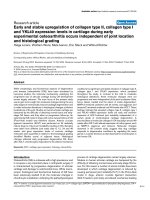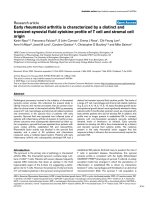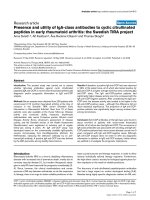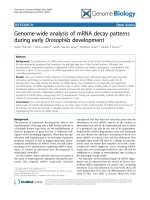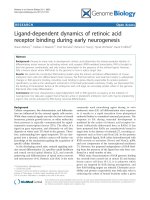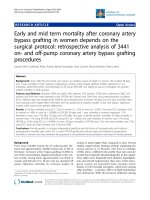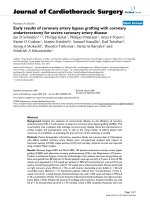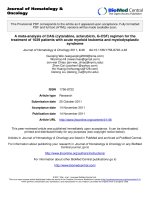Báo cáo y học: "Early norepinephrine resuscitation of lifethreatening hypotensive septic shock: it can do the job, but at what cost" pptx
Bạn đang xem bản rút gọn của tài liệu. Xem và tải ngay bản đầy đủ của tài liệu tại đây (102.35 KB, 1 trang )
Hamzaoui and colleagues [1] recently reported the eff ects
of early norepinephrine for septic shock with life-
threatening hypotension. eir observations fi rst answer
‘yes’ to the question ‘Can norepinephrine alone restore
mean arterial pressure (MAP) in septic shock?’ Second,
as an answer to ‘How does norepinephrine alone restore
MAP?’, they confi rm that norepinephrine restores MAP
despite minimal fl uid administration through ‘recruiting’
unstressed volume while allowing increased contractility
despite increasing afterload. e most critical question
that remains unanswered, however, is ‘Should nor epi-
nephrine alone be used to restore MAP in septic shock?’
If the price of fl uid resuscitation may be edema and organ
failure, what may be the price of norepinephrine
resuscitation? e fear is that the very same eff ects that
allow norepinephrine to recruit unstressed volume,
through alpha adrenergic eff ects on venous and arterial
vasculature, might recruit volume to the macrovas cu-
lature, all the while decreasing fl ow in previously
critically collapsible microvascular beds. Answers to this
crucial question are still unclear. In two previous
confl icting studies showing benefi cial [2] or detrimental
[3] eff ects on microvascular blood fl ow, the discrepancies
may have been due to diff erences in prior fl uid therapy
and ensuing preload reserve. In order to determine the
optimal use of norepinephrine, future studies of
microcirculation and perfusion should either optimize
on an indicator of fl uid responsiveness during the fl uid
therapy preceding norepinephrine treatment or rapidly
wean the inevitable early norepinephrine infusion rate
once the targeted MAP is obtained by screening for and
addressing preload dependency during infusion rate
decrements [4].
Abbreviations
MAP = mean arterial pressure.
Competing interests
The authors declare that they have no competing interests.
Published: 3 November 2010
References
1. Hamzaoui O, Georger J-F, Monnet X, Ksouri H, Maizel J, Richard C, Teboul J-L:
Early administration of norepinephrine increases cardiac preload and
cardiac output in septic patients with life-threatening hypotension.
CritCare 2010, 14:R142.
2. Jhanji S, Stirling S, Patel N, Hinds CJ, Pearse RM: The e ect of increasing
doses of norepinephrine on tissue oxygenation and microvascular ow in
patients with septic shock. Crit Care Med 2009, 37:1961-1966.
3. Dubin A, Pozo MO, Casabella CA, Palizas F, Jr., Murias G, Moseinco MC,
Kanoore Edul VS, Palizas F, Estenssoro E, Ince C: Increasing arterial blood
pressure with norepinephrine does not improve microcirculatory blood
ow: a prospective study. Crit Care 2009, 13:R92.
4. Kipnis E, Robin E, Vallet B: Re ning the tools for early goal-directed therapy
in septic shock. In Yearbook of Intensive Care and Emergency Medicine. Edited
by Vincent J-L. Heidelberg: Springer-Verlag; 2009:205-218.
© 2010 BioMed Central Ltd
Early norepinephrine resuscitation of life-
threatening hypotensive septic shock: it can do
the job, but at what cost?
Eric Kipnis* and Benoit Vallet*
See related research by Hamzaoui et al., />LETTER
*Correspondence: ;
Department of Anesthesiology and Critical Care Medicine, University Hospital of
Lille, Huriez Hospital - Rue Michel Polonovski, F-59037 Lille, France
doi:10.1186/cc9299
Cite this article as: Kipnis E, Vallet B: Early norepinephrine resuscitation of
life-threatening hypotensive septic shock: it can do the job, but at what
cost?. Critical Care 2010, 14:450.
Kipnis and Vallet Critical Care 2010, 14:450
/>© 2010 BioMed Central Ltd
